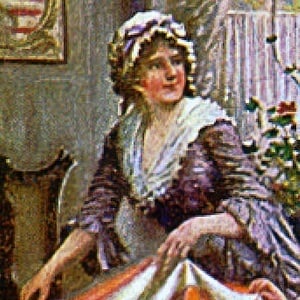


For the former–especially in the run-up to the War of 1812, the heroic age of her work as a flagmaker, from which the lion’s share of archival references to her survive (another surprise) –she made garrison flags that flew over port communities from New Orleans (where her sister Mary’s boys had set up as merchants) to Niagara. If the conversation around Betsy’s dinner table took in global politics and events, she had a more direct hand in international affairs as she fabricated dozens of flags for the U.S. Correspondence to and from Liverpool, Madeira and Calcutta kept one another abreast of kin and commerce alike. Betsy’s ship-captain son’s-in-law and nephews, too became agents of international commerce: letters that crossed Betsy’s Front Street threshold advised when a cargo of salt might sell well in Brazil, and when sugar could be had cheap in Pemambuco. customs inspector, and spent his days greeting the ships that brought the goods of the world to Philadelphia’s wharves: limes, oranges, sweetmeats, coffee, sugar, cigars from the West Indies, indigo from the Haitian port Anse-à- Veau, and Liverpool coal by the ton. Betsy’s third husband, John Claypoole, was also a privateer likewise imprisoned after the war he would travel to South America to look into a plantation he’d received by bequest, and in time he landed a plum job as a U.S. After his ship was outgunned and he was imprisoned in England, Ashburn died, leaving his bride a widow. After the death of her first husband, John Ross, in 1776, she married mariner Joseph Ashburn, a privateer who spent much of his time at sea. Having grown up in arguably the most important city across England’s two-dozen Atlantic and Caribbean colonies, the young Elizabeth Griscom surely harbored some sense of her comparative sophistication among British colonists worldwide, but the outbreak of Revolution made her aware of the world in new ways.

Trapped for more than two centuries now in her Arch Street parlor, contained there by the thousands of images that have been produced and reproduced on stamps and stationery, towels and teacups, of the beaming seamstress presenting her handiwork to an admiring General Washington (here in the famous painting by Charles Weisgerber), Betsy Ross (or Elizabeth Griscom Ross Ashburn Claypoole, 1752-1836) in real life was very much a woman of the world, no less alert to developments around the globe than we are today.

By Marla Miller As I’ve spent the last few months giving talks about Betsy Ross, probably the most-frequently-asked question that gets posed by audience members is, “what surprised you most?” It’s been hard to know where to begin, but lately I’ve been thinking that what surprises me most - or maybe, in truth, which of the various discoveries has pleased me the most - is how broad her horizons really were.


 0 kommentar(er)
0 kommentar(er)
